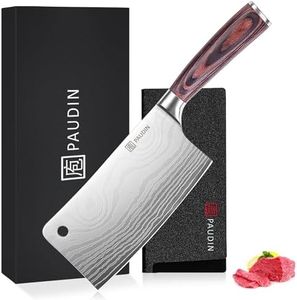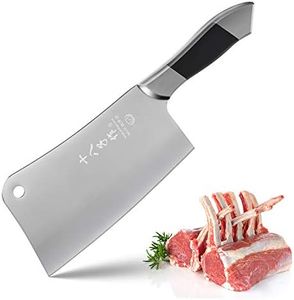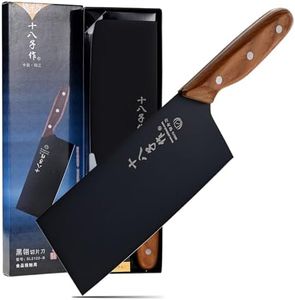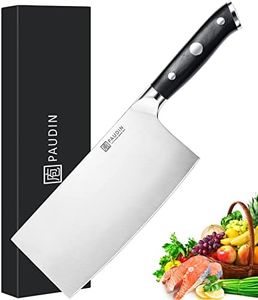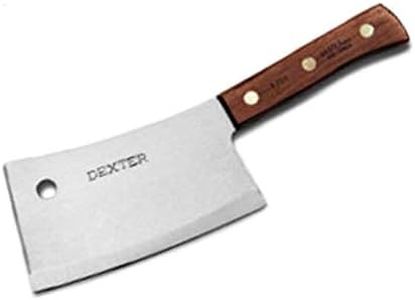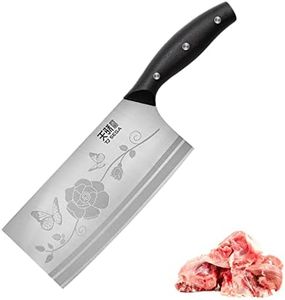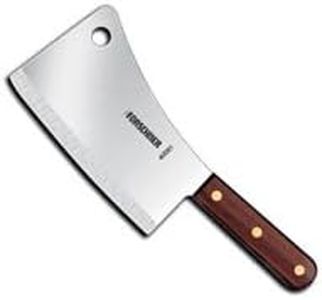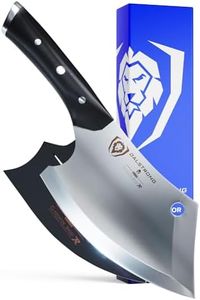We Use CookiesWe use cookies to enhance the security, performance,
functionality and for analytical and promotional activities. By continuing to browse this site you
are agreeing to our privacy policy
10 Best Meat Cleavers
From leading brands and best sellers available on the web.Buying Guide for the Best Meat Cleavers
Choosing a great meat cleaver is all about matching the tool to what you actually plan to do in your kitchen. Meat cleavers are heavy-duty knives made to handle tough cutting tasks like chopping through bones, thick meat, or hard vegetables. Not every home cook needs a professional grade option—think about what kinds of foods you prepare, how often you’ll use the cleaver, and what feels comfortable in your hand. Making the right pick means paying attention to design, weight, handle comfort, and the blade, so your cleaver helps you work safely and efficiently with less strain.Blade MaterialThe material of the blade determines how sharp, durable, and easy to maintain your meat cleaver will be. The most common options are stainless steel and high-carbon steel. Stainless steel resists rust and is easy to care for, making it a good all-purpose choice for most kitchens, especially if you want something low-maintenance. High-carbon steel can take a sharper edge and is usually favored for heavy-duty or professional-level use, but it requires careful drying and upkeep to avoid rust. If you chop bones or dense meats regularly, sturdier steel is beneficial, while occasional users will appreciate the convenience of stainless.
Blade Weight and ThicknessMeat cleavers vary greatly in how heavy and thick the blade is. Thicker, heavier blades (sometimes over 1/4 inch and about 1-2 pounds) are great for cutting through bone and hard cartilage, and are typically used for butchery or more intense tasks. Lighter, thinner blades are easier to maneuver and work well for chopping meat or hard vegetables when precision matters more than brute force. If you mainly slice and chop boneless meats or veggies, pick a lighter cleaver; for breaking down whole chickens or ribs, a heavy-duty option is best.
Blade SizeCleavers come in various blade sizes, usually ranging from about 6 to 9 inches in length. A longer blade can handle bigger cuts of meat or larger bones, while a shorter blade offers more control and is less intimidating for less experienced users. Consider both your own comfort handling larger blades and the typical size of the food you’ll prep—a smaller cleaver is versatile for everyday home use, while a large one suits big butchery tasks.
Handle Design and MaterialThe handle impacts both safety and comfort. Handles are commonly made from wood, plastic, or composites. Wood gives a classic feel and a secure grip, but it can be prone to damage from moisture if not cared for properly. Plastic and composite handles are generally easier to clean and hold up better in busy kitchens, but may not feel as traditional. The shape and ergonomics matter too—if you have smaller hands, a slim handle will be more comfortable, while larger handles suit bigger hands or heavy cleavers. Try to pick a handle that feels steady in your grip and doesn't slip easily.
Balance and FeelBalance refers to how the weight is distributed between the blade and handle. A well-balanced cleaver won’t feel too blade-heavy or too light in the handle, making cutting easier and reducing fatigue. If you frequently do a lot of chopping or plan long prep sessions, balance becomes especially important—it’s a good idea to test how the cleaver feels in your hand or look for reviews mentioning comfort during use. If you just need a cleaver for the occasional big job, you might not need to worry quite as much, but don’t overlook this feature if you want smoother, safer cutting.
Edge Sharpness and Ease of SharpeningA sharp edge makes cutting safer and more efficient, but some blades are easier to keep sharp than others. High-carbon steel usually sharpens up quickly and holds a keen edge for tough jobs, while stainless is slower to dull but can be a little harder to re-sharpen. If you don't have sharpening experience, a cleaver that’s easy to maintain will be preferable. Also, if you primarily chop bones, you’ll want a robust edge that can take some abuse, while for fine slicing, you'll want the thinnest, sharpest edge you can comfortably maintain.

